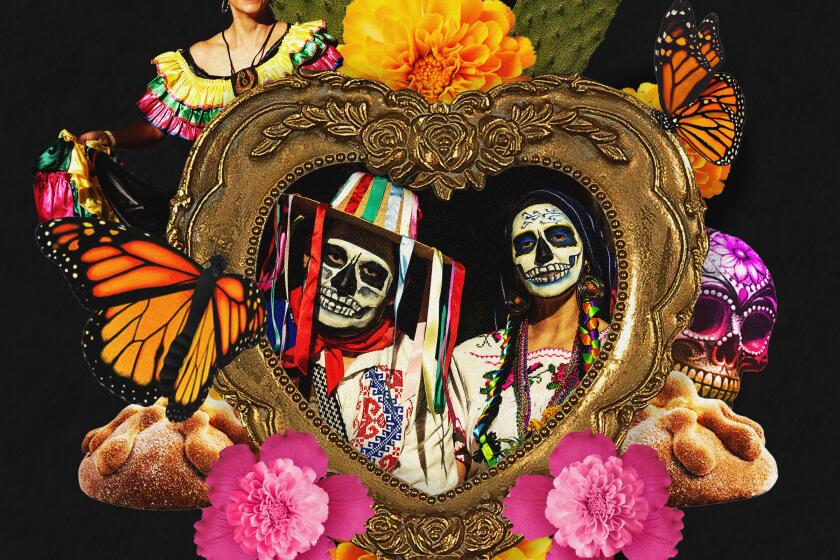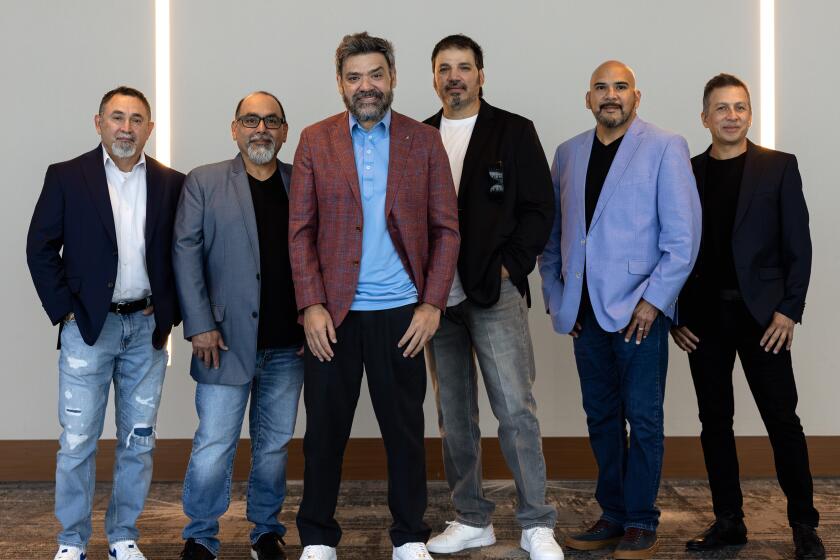
- Share via
When L.A. Opera invited Gustavo Santaolalla to write a new score for the Spanish version of the 1931 film “Dracula” to be performed live with an orchestra, the Oscar-winning composer was intrigued by the potential to combine traditional movie soundtrack techniques with an experimental approach.
“Dracula is such a foundational myth,” he says. “I tried to combine the feelings that classic horror movies evoke in me with a modern approach — and imbue it all with an intense sense of romanticism.”
It’s a windy afternoon in the hills of Echo Park. Santaolalla has just arrived for a photo session at the recording studio that he shares with Aníbal Kerpel, his decades-long co-producer, virtuoso sound engineer and musical partner in crime.
Sitting by the mixing console, Santaolalla looks like a sage from a fantasy novel, with his thick white beard and warm smile. He has many things on his mind — he’s currently creating his own personal fragrance for men, as well as designing a variation of the South American folk string instrument known as ronroco — but the “Dracula” opening is fast approaching. He’s excited about his first rehearsal with the Los Angeles Opera orchestra, led by resident conductor Lina González-Granados.

“I knew nothing about this alternate Dracula film,” he says, referring to the Spanish-language version, shot at night with Latino actors on the same sets used during the day for the Bela Lugosi classic. “I thought that it had very little music and was somewhat languid. I feel my score will allow viewers to bypass the over-the-top antics of those early sound films from the 1930s, and concentrate on the great characters that inform the movie.”
At 73, Santaolalla is a soundtrack renaissance man. He kicked off his career as a teen rock star in Buenos Aires with Arco Iris, one of the first rock en español bands. The ‘90s found him in Los Angeles, where he became the most transcendent producer in the history of Latin American rock. Collaborating with Kerpel, he helmed seminal albums by the likes of Café Tacvba, Maldita Vecindad, Julieta Venegas, Molotov, and Juanes, among others.
Touring and recording with his own neo-tango band, Bajofondo, seemingly wasn’t enough of an extracurricular activity. After his haunting solo album Ronroco became a favorite among tastemakers in the late ‘90s, Hollywood started calling the Echo Park studio. Santaolalla won best original score Oscars two years in a row for “Brokeback Mountain” and “Babel,” and recently gained younger fans writing the score for the video game and television adaptation of the post-apocalyptic saga “The Last of Us.”
Día de Muertos: Here’s your events guide for Los Angeles, Orange County and Ventura counties bringing communities together in celebration
“The other day, a young woman told me that she’s been listening to my music since she was 10,” he says. “Getting to write the score for ‘The Last of Us’ at this stage in my career has been nothing short of amazing. I will be gone from this world, and people who will be 45 or 50 years old will be humming the main theme and saying to each other, ‘Remember that?’ ”
“An entire generation of young listeners who were not familiar with Gustavo’s work got to discover him through ‘The Last of Us,’ ” adds Kerpel. “They not only loved it, but were also deeply moved by it. I’ve been working with the man for 45 years, and I’m still amazed by how fresh and innocent his music sounds. Sometimes he brings a new theme and it’s only two or three notes. The simplicity of his genius hits you on a visceral level.”
A self-taught musician, Santaolalla doesn’t read or write music, but relies instead on a brilliant instinct for generating soulful melodies, and his eccentric tendency to employ all sorts of household objects and rare instruments to create texture and sound. The “Dracula” score supplements the Los Angeles Opera orchestra with a Stroh violin (amplified by a metal resonator and horn), an accordion and a foley artist and mixer duo. Santaolalla will play the guitar and ronroco.

“I decided not to limit myself to the sounds of the orchestra,” he explains. Working with synths and samplers allowed him to reinforce the subharmonics and add potency to the score. Guest musician Michael Ward-Bergeman plays the electric accordion with pedals, which can make it sound like a church organ.
“It’s an interesting touch, because the folk music of Transylvania sounds vaguely like tango music. I’ve always felt that ‘Dracula’ had a bit of a Carlos Gardel aura about him,” he laughs, referencing the tango icon of his native Argentina.
Incorporating foley artists — sound FX technicians from the film industry — to live performance is something that Santaolalla had considered for some time. For years, he had thought of having a foley artist instead of a percussionist in his band, so that he could recreate natural textures like water and the wind.
The titans of Tejano music look back at three decades of hits, becoming a norteño powerhouse and the freedom of making music on their terms.
“There are scenes with galloping horses in the film, and the sound of the hoofs will match the rhythm of the music,” he says. “Even though the orchestra will be performing in semi-darkness, having a foley artist could be intriguing on a visual level. He will be playing the sounds of the bats flapping their wings — the rumbling thunderstorm, and the rain.”
I ask Santaolalla if he’s nervous about hitting all the cues when performing the score live as the film is projected.
“With this kind of orchestral show, you usually have one rehearsal the day before, another one the day of the show, and then you go live,” he says. “But the caliber of these musicians is amazing. When it’s time to go live, they just shine. I’ve done shows with an orchestra before, and everything comes together during that first performance. It’s an extraordinary experience.”
Even though Santaolalla’s physical mobility has been limited in recent years, his schedule remains frantic. Perhaps it is his restless creativity.
“I’ve never liked staying in my comfort zone, and I love taking on new challenges,” he says. “This attitude has never failed to give me positive results.”
“I’ve also tried to maintain a certain level of innocence when tackling projects like this one,” he adds. “If you’re intimidated by the thought of writing the score for ‘Dracula,’ you’re off to a bad start. Instead, how about we have some fun? Let’s see what we discover in the process. At the end of the day, the music is permeated by the same melancholy touch that is ever present in everything I do.”
More to Read
The Latinx experience chronicled
Get the Latinx Files newsletter for stories that capture the multitudes within our communities.
You may occasionally receive promotional content from the Los Angeles Times.








